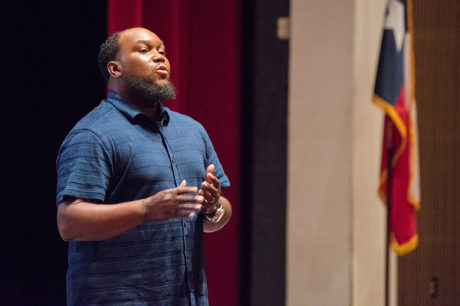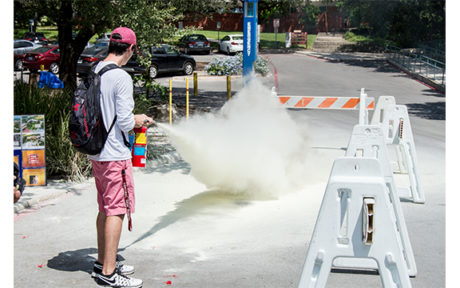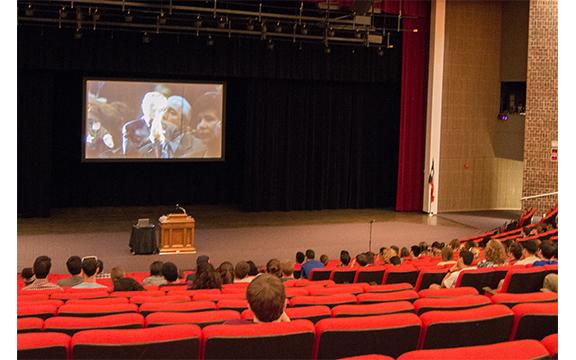A crowd of about 100 students gathered in Laurie Auditorium on Tuesday, Sept. 5, to watch Alvaro Llanos and Shawn Simons present their documentary, “After the Fire: A True Story of Heroes and Cowards.”
Llanos and Simons are burn victims from the Seton Hall University dormitory fire that occurred on Jan. 19, 2000. The fire, a product of arson, killed three of their classmates. Their documentary follows their recovery from major burns, as well as the arson investigation. Llanos and Simons’ mission in touring the country and sharing their story is to prevent such tragedies through education on fire safety.
“We do this presentation somewhere between 220 and 250 times per year. It’s difficult to talk about the most difficult time of our lives, but it’s something that we are passionate about because we don’t want it to happen on any other campus. We want people to realize the importance of fire safety, especially with the young adults who think they are invincible,” Simons said.

The majority of student attendants were first-year students and members of Residential Life, such as Ari Fletcher, a resident assistant in Witt-Winn residence hall.
“I want to learn more about what happens when people actually have fire crises because I’m an RA, and I want to learn how real people have dealt with these things,” Fletcher said.
This is the second year Llanos and Simons have visited Trinity. Their presentation was discovered by Paul Chapa, chief of the Trinity University Police Department, at a campus law enforcement conference in Montreal in 2014.
“Llanos and Simons’ presentation was so compelling to me that I knew that this was a presentation that we had to bring to Trinity. Based on my experiences here, when fire alarms go off, students may not evacuate as quickly as they need to. If their story just impacted one Trinity student who knew when that alarm went off, it was time to get out of there, then we just saved that one life,” Chapa said.
Students at Trinity are no stranger to 5 a.m. fire alarms. Ivan Pendergast, crisis management team coordinator, asserts that even though you may think the alarm is misfiring, you need to get out quickly as possible.
“Our fire alarms sometimes go off a little more than we want them to. They’re not malfunctions, they’re undesired alarms where somebody burnt the popcorn, or somebody boiled too much water in the kitchenette,” Pendergast said. “They are very sensitive, and they will go off quickly. In any instance when you’re sitting in your room and you hear the fire alarm, get out, because that’s when the fire is going to be at its smallest. That’s when the greatest possibility of getting out unscathed and unharmed is going to be, and every moment that you delay inside the building increases the danger.”
Besides increased fire safety awareness through Llanos and Simons’ presentation, the university is taking steps to increase knowledge through training programs. On the day of the “After the Fire” presentation, students were given hands-on fire extinguisher training.
“On Tuesday, in front of Witt Reception, we had firefighters from the San Antonio Fire Department partner with environmental health and safety in training students on how to use a real fire extinguisher and extinguish an actual fire. In the short span of two hours we had over 71 students participate. It was well-received. This is just a small step in getting students to understand the basics of fire and life safety,” said Ozzie Crespo, director of environmental health and safety.

In addition, Crespo’s department has added fire safety training programs to Residential Life training.
“We provided a smoke-filled room demonstration for the RAs. We filled up a room with smoke, and by doing that, we gave them the experience of walking through a smoke-filled room. This was the first year we did that. I hope that’s something that will continue. We got pretty good feedback, and hopefully we can extend it out to staff and other students, as well,” Crespo said.
Chapa wanted to leave students with a piece of advice.
“The Trinity University Police Department is here to provide students with a safe and secure environment. Though we have a responsibility to respond, the students have a responsibility for their safety as well, so we want to partner with them to address these situations, and hopefully through that partnership, we can save lives,” Chapa said.
More information about fire safety and procedure at Trinity can be found at inside.trinity.edu/environmental-health-safety.







